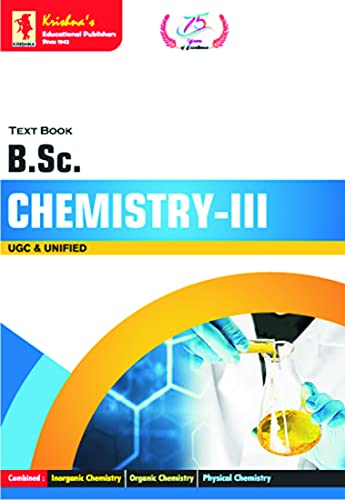
Krishna's - B.Sc. Chemistry III, Edition-3B PDF
987 Pages·2021·11.3449 MB·other
Most books are stored in the elastic cloud where traffic is expensive. For this reason, we have a limit on daily download.
Preview Krishna's - B.Sc. Chemistry III, Edition-3B
Description:
SYLLABUS- B.Sc. CHEMISTRY-III,
INORGANIC CHEMISTRY-III
B.Sc. III Year Paper-I
UNIT-I
I. Metal-ligand bonding in Transition Metal Complexes: Limitations of valance bond
theory, an elementary idea of crystal field theory, crystal field splitting in octahedral,
tetrahedral and square planner complexes, factors affecting the crystal-field parameters.
II. Thermodynamic and Kinetic Aspects of Metal Complexes: A brief outline of
thermodynamics stability of metal complexes and factors affecting the stability, stability
constants of complexes and their determination, substitution reactions of square planar
complexes.
UNIT-II
III. Magnetic Properties of Transition Metal Complexes: Types of magnetic behavior,
methods of determining magnetic susceptibility, spin-only formula, L-S coupling, correlation
of ms and meff values, orbital contribution to magnetic moments, application of magnetic
moment data for 3d-metal complexes.
IV. Electronic spectra of Transition Metal Complexes: Types of electronic transitions,
selection rules for d-d transitions, spectroscopic ground states, spectrochemical series, Orgel-
energy level diagram for d1 and d9 states, discussion of the electronic spectrum of
[Ti(H2O) 6] 3+ complex ion.
UNIT-III
V. Organometallic Chemistry: Definition, nomenclature and classification of
organometallic compounds, Preparation, properties, bonding and applications of alkyls and
aryls of Li, Al, Hg, Snl. Metal carbonyls: 18 electron rule, preparation, structure and nature of
bonding in the mononuclear carbonyls.
VI. Silicones and Phosphazenes: Silicones and phosphazenes as examples of inorganic
polymers, nature of bonding in triphosphazenes.
UNIT-IV
VII. Hard and Soft Acids and Bases (HSAB): Classification of acids and bases as hard and
soft,
ORGANIC CHEMISTRY-III
B.Sc. III Year Paper-II
PHYSICAL CHEMISTRY-III
B.Sc. III Year Paper-III
UNIT-I
(Introductory Quantum Mechanics, Spectroscopy, Physical Properties and Molecular
Structure)
I. Introductory Quantum Mechanics: Black-body radiation, Planck's radiation law,
photoelectric effect, heat capacity of solids, Bohr's model of hydrogen atom (without
derivation) their solution of overall solution and its defects, Compton effect, de-Broglie's
hypothesis, the Heisenberg's uncertainty principle, Hamiltonian Operator.
II. Spectroscopy: Introduction: electromagnetic radiation, regions of the spectrum, basic
features of different spectrophotometers, statement of the born-oppenheimer approximation,
degrees of freedom.
UNIT-II
IV. Elementary Quantum Mechanics: Schrödinger wave equation and its importance,
physical interpretation of the wave function, postulates of quantum mechanics, particle in a
one dimensional box.
UNIT-IV
(Photochemistry, Solutions, Dilute Solutions and Colligative Properties)
VI. Photochemistry: Interaction of radiation with matter, difference between thermal and
photochemical processes, Laws of photochemistry: Grothus-Drapper law, Stark-Einstein law,
Jablonski diagram depicting various processes occurring in the excited state, qualitative
description of fluorescence, phosphorescence, non-radiative processes (internal conversion,
intersystem crossing), quantum yield, photosensitized reactions energy transfer processes
(simple examples), Kinetics of Photo chemical reaction
INORGANIC CHEMISTRY-III
B.Sc. III Year Paper-I
UNIT-I
I. Metal-ligand bonding in Transition Metal Complexes: Limitations of valance bond
theory, an elementary idea of crystal field theory, crystal field splitting in octahedral,
tetrahedral and square planner complexes, factors affecting the crystal-field parameters.
II. Thermodynamic and Kinetic Aspects of Metal Complexes: A brief outline of
thermodynamics stability of metal complexes and factors affecting the stability, stability
constants of complexes and their determination, substitution reactions of square planar
complexes.
UNIT-II
III. Magnetic Properties of Transition Metal Complexes: Types of magnetic behavior,
methods of determining magnetic susceptibility, spin-only formula, L-S coupling, correlation
of ms and meff values, orbital contribution to magnetic moments, application of magnetic
moment data for 3d-metal complexes.
IV. Electronic spectra of Transition Metal Complexes: Types of electronic transitions,
selection rules for d-d transitions, spectroscopic ground states, spectrochemical series, Orgel-
energy level diagram for d1 and d9 states, discussion of the electronic spectrum of
[Ti(H2O) 6] 3+ complex ion.
UNIT-III
V. Organometallic Chemistry: Definition, nomenclature and classification of
organometallic compounds, Preparation, properties, bonding and applications of alkyls and
aryls of Li, Al, Hg, Snl. Metal carbonyls: 18 electron rule, preparation, structure and nature of
bonding in the mononuclear carbonyls.
VI. Silicones and Phosphazenes: Silicones and phosphazenes as examples of inorganic
polymers, nature of bonding in triphosphazenes.
UNIT-IV
VII. Hard and Soft Acids and Bases (HSAB): Classification of acids and bases as hard and
soft,
ORGANIC CHEMISTRY-III
B.Sc. III Year Paper-II
PHYSICAL CHEMISTRY-III
B.Sc. III Year Paper-III
UNIT-I
(Introductory Quantum Mechanics, Spectroscopy, Physical Properties and Molecular
Structure)
I. Introductory Quantum Mechanics: Black-body radiation, Planck's radiation law,
photoelectric effect, heat capacity of solids, Bohr's model of hydrogen atom (without
derivation) their solution of overall solution and its defects, Compton effect, de-Broglie's
hypothesis, the Heisenberg's uncertainty principle, Hamiltonian Operator.
II. Spectroscopy: Introduction: electromagnetic radiation, regions of the spectrum, basic
features of different spectrophotometers, statement of the born-oppenheimer approximation,
degrees of freedom.
UNIT-II
IV. Elementary Quantum Mechanics: Schrödinger wave equation and its importance,
physical interpretation of the wave function, postulates of quantum mechanics, particle in a
one dimensional box.
UNIT-IV
(Photochemistry, Solutions, Dilute Solutions and Colligative Properties)
VI. Photochemistry: Interaction of radiation with matter, difference between thermal and
photochemical processes, Laws of photochemistry: Grothus-Drapper law, Stark-Einstein law,
Jablonski diagram depicting various processes occurring in the excited state, qualitative
description of fluorescence, phosphorescence, non-radiative processes (internal conversion,
intersystem crossing), quantum yield, photosensitized reactions energy transfer processes
(simple examples), Kinetics of Photo chemical reaction
See more
The list of books you might like
Most books are stored in the elastic cloud where traffic is expensive. For this reason, we have a limit on daily download.
